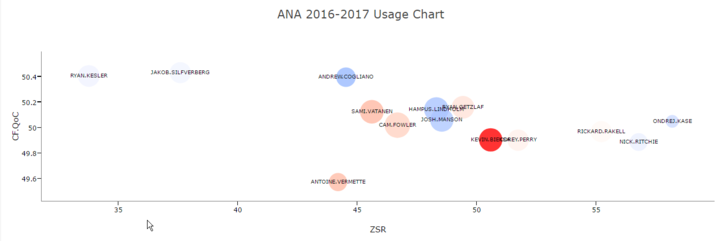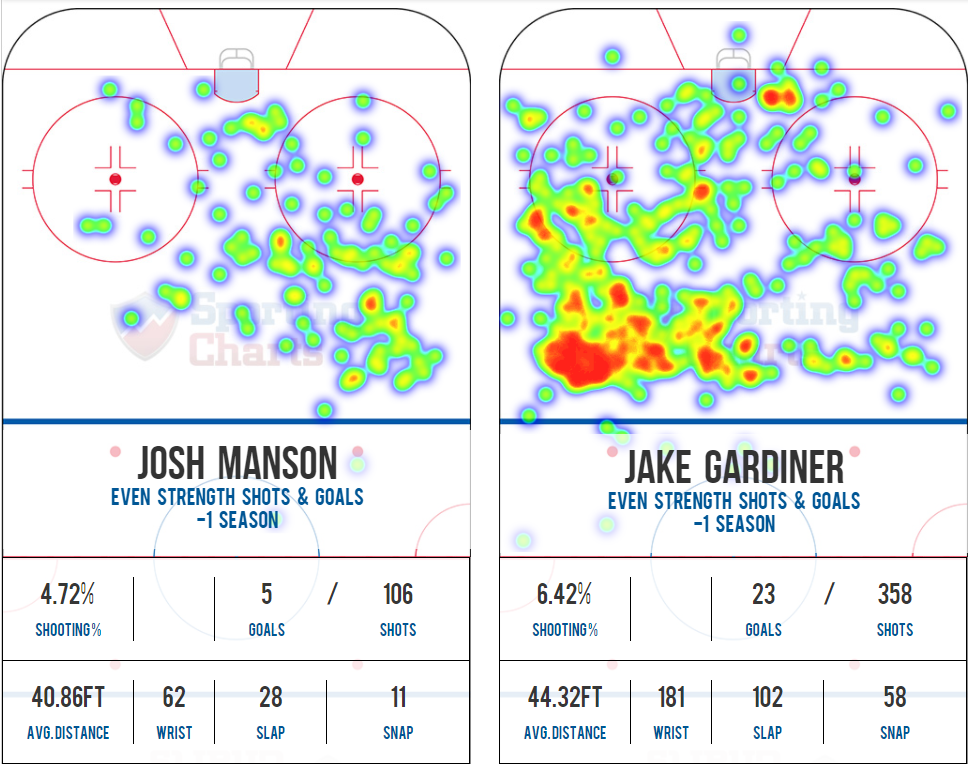It wasn’t long ago that most Maple Leafs fans knew next to nothing about Josh Manson, but the 25-year-old Anaheim Ducks defenceman has quickly become a topic of conversation as a prime trade target to fill out the Leafs’ top four.
One of the main reasons we are starting to see Manson’s name pop up in trade rumours is the challenge facing the Ducks in the 2017 expansion draft.
Most clubs will opt for the seven forwards, three defencemen and one goalie protection scheme for the draft. If the Ducks opt for the 7-3-1, with Hampus Lindholm and Cam Fowler locks to be protected, the Ducks will be in the tough spot of choosing between Sami Vatanen and Manson for the final spot on defence. If they opt for the alternate scheme and protect an extra defenceman at the expense of a forward, they’ll lose Jakob Silfverberg, a 49-point scorer this season who has nine goals in 14 playoff games and is signed to a cap-friendly contract ($3.75 million for two more years).
(For the purposes of this article, we’re assuming Kevin Bieksa will either waive his No Movement Clause or be bought out. That may not be a guarantee.)
If we assume the Ducks go with the 7-3-1 in order to protect Silfverberg, they’ll likely test the trade market on both Manson and Vatanen in order to make an informed choice between the two with their respective trade values in mind. Vatanen has had a down season production-wise in his first season under Randy Carlyle — 24 points in 71 games is his worst points-per-game rate since he broke the league full time — but he plays more all-situations minutes than Manson (21:39 per game vs. 18:37) and has handily outproduced him to this point in their careers. The two played about the same amount on the penalty kill and at even strength, but Vatanen played significant power play minutes whereas Manson did not feature at all on the man advantage.
Contract wise, Manson has one season left at $825,000, while Vatanen signed a four-year, $4.875 mill AAV contract last summer. The Ducks have no significant free agents (rental Patrick Eaves, Nate Thompson, Jonathan Bernier is the extent of it), but they will be very tight to the cap again next year with $70.7 million committed to 21 players. Clayton Stoner — currently on LTIR, allowing the Ducks to exceed the cap — should be ready to return next season and could pose a problem with a $3.25 million contract through 2017-18.
If it turns out the Ducks opt to fetch something for Manson via trade, the dots do connect with a Leafs team that is need of a defensively proficient rearguard. Of course, many other NHL teams will also have an interest in Manson — he’s a quality 25-year-old right-handed defenceman who will be paid cheaply for one more season, after which he becomes an RFA.
Josh Manson’s Usage
In modern-day hockey analysis, It has become essential to consider usage when evaluating a player. It helps give us an idea of player roles, the quality of performance within those roles, and therefore a sense of where a player may fit in the future. Mainly, it helps eliminate some of the uncertainty when evaluating a player, as usage can have a significant effect on a player’s overall numbers.
The following graph gives us some insight into how Manson was deployed this past season. On the X-Axis is the percentage of non-neutral zone faceoffs that Manson started in the offensive zone, and on the Y-Axis is the weighted average CF% of the player’s opponents.

Manson’s usage doesn’t seem to be too difficult or too easy. He’s deployed in the offensive zone for just under 50% of his non-neutral zone faceoffs, while his competition’s average CF% is a hair over 50%. He does face relatively difficult usage compared to his fellow Ducks defencemen; Folwer and Vatanen have enjoyed slightly easier deployment while Manson and Lindholm, who played together for a significant portion of the regular season, have often been Randy Carlyle’s matchup pair.
Scouting Report: Josh Manson
Now that we’ve established that Manson has produced some good defensive results, let’s take a look at how he goes about achieving those defensive numbers on the ice.
He has several characteristics that make him effective defensively:
- Good Stick
- Strong
- Mobile
- Poised
- Good Gap Control
Let’s take a look at some examples to help us understand exactly how Manson is effective in these categories.
I
Manson picks up the puck just in front of his scrambling goaltender. He quickly escapes danger by carving around the net and moves the puck to his winger on the tape off the backhand with three Oilers applying pressure.
I
The Canucks start a counter attack up ice as Rackell sticks with his man. Manson maintains a good gap with Gaunce, and when the attempted pass is tipped into the air, Manson swats it away with a great display of hand-eye.
I
After Ben Hutton takes an opportunity to rush the puck up ice, Manson gaps up as he comes through the middle and lays an open-ice hit, aggressively disrupting a potentially dangerous rush for Vancouver, who had numbers.
I
Manson reads the pass by Chris Tanev as he tries to play the puck up the wing to Daniel Sedin, and times his pinch well to win the battle and keep the puck in the offensive zone.
I
As he goes to receive puck behind the net on his backhand, Manson reads the San Jose forecheck with a quick shoulder check, surveys his options and makes a nice backhand pass on his off-side for a clean breakout.
While these are only a few hand-selected plays out of the dozens that happen over the course of a hockey game, they are a good indicator of the type of things you’ll notice regularly in Manson’s game. It’s not hard to watch a Ducks game and find a situation or battle he comes out ahead on.
Defensively, Manson has a lot going for him:
– He’s a good skater, an essential quality for a defenceman in the modern game. That allows him to keep up with faster skaters off the rush, scramble to loose pucks, and split away from forecheckers while breaking the puck out. In a straight line, he can keep up with most players in the league with his long, powerful stride. He grades as an above-average skating defenceman, in my book.
– I also noticed Manson “mohawks” frequently when skating. He’ll often do it when receiving the puck and use the move as a pivot to change direction. It’s not something we see many defencemen execute with the confidence that Manson does.
– He’s really strong. He gains body position with ease in puck battles and head-to-head races to the puck. He’ll also fight just about anyone and engages in scrums often (You can decide for yourself how important that is).
– A less-explored aspect of defensive play, in my view, is the “good stick” factor. Being able to use one’s stick to bat pucks away and poke check is a specific defensive skill. With the frequency that Manson makes positive plays with his stick, I believe it’s something he’s legitimately very good at.
– While I’ve mentioned Manson’s skating prowess, Manson can occasionally get caught thinking he has more time than he does. He’s not incredibly agile, nor is he an elite puck handler, so he will sometimes struggle when he has to make a quick play under duress.
The Numbers
Simply looking at Manson’s Corsi against numbers understandably causes excitement among fans, but a complete picture of a player has to encompass more than one stat. With that said, his ability to limit opponent’s shot attempts is really something:
[wpdatachart id=116]
Relative CA/60 of all Ducks defencemen who played at least 300 mins in 2016-17
Manson allows more than eight fewer shot attempts against than his average teammate. Considering he takes on some of the toughest minutes on the team, this is highly impressive.
In fact, Manson has allowed the second fewest shot attempts against per hour of any NHL defenceman who has played at least 500 minutes since the 2014-15 season.
Diving into further detail, let’s look at how he performs defensively in terms of goal metrics as well as some of his offensive numbers.
Of defencemen with at least 100 minutes played since 2014, Manson is:
Score, Venue, and Zone adjusted
- 4th in CA/60
- 4th in SA/60
- 4th in FA/60
- T-23rd in xGA/60
- 32nd in GA/60
Manson’s numbers reveal a perplexing trait we see with quite a few players across the league. He’s a darling in terms of shot-based metrics, but he falls off by comparison in goal-based metrics (although they’re still good). Shot-based numbers help predict future results with more accuracy than goal-based ones, but with a sample size as big as this one, goal-based metrics carry weight (although I would argue that they are more influenced by the difficulty of competition).
In terms of offensive stats, Manson is obviously less impressive. Surprisingly, though, he still produces some good numbers. Among the Ducks’ eight regular defencemen in 2016-17 (at least 200 minutes played), he was fourth or higher in Corsi For, Goals For, and Scoring Chances For per hour.
While I don’t see much confidence from Manson when it comes to offence, his numbers suggest he’s got some potential. He’s hesitant to commit in the offensive zone and doesn’t thrive making quick plays at the blue line, but he’s smart, a good skater, and has a solid shot. There are enough tools there.
As a representation of what to expect from Manson offensively, here’s his offensive zone shot heat map from 2014-16:

Compared to a defenceman like Gardiner — who produces shots at the rate of a top-60 defenceman in the league — he’s predictably underwhelming.
Penalty differential is arguably an underrated stat and it’s something Manson struggled with this season. He posted the worst differential of any regular Ducks defenceman and ranked in the bottom 20 in the league among defencemen in 2016-17. It’s something to be aware of; it’s no doubt a less desirable byproduct of his aggressive style of play.
Where would Manson fit in the Leafs’ lineup?
In practice on March 16, Babcock made some changes to his defensive pairings, something he hadn’t done much of prior. He moved Gardiner onto a pair with Zaitsev and Rielly with Carrick. Most of us assumed at the time that it was unlikely to stick and that the coaching staff was merely experimenting, but the pairings ended up staying that way for the most part. As a result, Gardiner was all of a sudden forced into a heavy matchup role after receiving relatively easy minutes alongside Carrick for most of the season.
Gardiner thrived in the new role. Considering Babcock kept Gardiner in that spot throughout the playoffs, it’s quite possible he will stick with it to start the 2017-18 season. On paper, Manson could be an excellent fit next to Gardiner, who has been a shot-suppressing and shot-generating machine for his entire career. It has the makings of a really good matchup pair with strong two-way ability.
While Manson would come with an acquisition cost, his contract situation (one more season at $825,000) would give the Leafs the added benefit of being able to evaluate how he performs on a new team with new linemates before committing to him as a solution on the right side of their top-four long term.
Whoever ends up with Josh Manson on their blueline next year — whether it’s Anaheim, Las Vegas, Toronto, or another team — will be lucky to have him. He’s a truly capable defensive player and his combination of mobility, strength and smarts would entice any NHL team looking to improve its blue line.


































